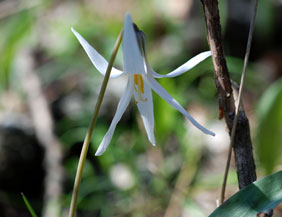WHITE FAWN LILY
|
 |
| File Size: 46 KB |
|
|
|
Erythronium albidum Nutt.
|
| Konza Prairie, Riley County, Kansas |
| Perennial |
| Height: 4-8 inches |
| Family: Liliaceae - Lily Family |
| Flowering Period: March, April |
|
| Also Called: | | White dog's-tooth violet, trout lily, fawn lily. | | Stems: | | Stemless | | Leaves: | | 2 in flowering form, 1 in non-flowering sterile form; elliptical-lanceolate to ovate-lanceolate, up to 6 inches long, .2 to 1.6 inch wide, flat to slightly folded, waxy, brownish-purplish mottled (occasionally not so when mature); tips tapering to slender points. | | Inflorescences: | | Solitary flower terminating stout stalk 4 to 8 inches long. | | Flowers: | | About 1 inch wide; perianth segments 6, similar, lanceolate, .8 to 1.6 inches long, white, tinged pink or lavender abaxially, with yellow adaxial spot at base, reflexed in bloom; stamens 6, yellow. | | Fruits: | | Capsule, rounded, erect or nodding, held off ground; seeds 1-3. | | Habitat: | | Moist woods and thickets, often on south slopes. | | Distribution: | | East 1/2 of Kansas. | | Comments: | | Occurs in large colonies, but often only a few plants flower. The common names "fawn lily" and "trout lily" refer to the mottling of the leaves which resembles the spots on a fawn's back or the speckling on a trout. The common name "dog's-tooth" refers to the resemblance of the bulb to a dog's tooth in Erythronium dens-canis which was used by Linnaeus to establish the genus. North American species have thick bulbs that bear little resemblance to a dog's tooth, so the name makes no sense here. English authors often formerly referred to any delicate flower as a "violet". |
|
| White fawn lily inflorescence |  | | 82 KB | | Konza Prairie, Riley County, Kansas |
| | White fawn lily |  | | 112 KB | | Konza Prairie, Riley County, Kansas |
| | White fawn lily flower |  | | 76 KB | | Konza Prairie, Riley County, Kansas |
| | White fawn lily leaf |  | | 111 KB | | Konza Prairie, Riley County, Kansas |
| | White fawn lily |  | | 45 KB | | Shawnee County, Kansas |
| | White fawn lily |  | | 74 KB | | Schermerhorn Park, Cherokee County, Kansas |
| | White fawn lily |  | | 100 KB | | Schermerhorn Park, Cherokee County, Kansas |
| | White fawn lily |  | | 143 KB | | Johnson County, Kansas |
| | White fawn lily |  | | 105 KB | | Jefferson County, Kansas |
| |
|
|
|
|
|
|